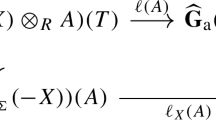Abstract
The main fields of application of formal groups are algebraic geometry and class field theory. The later uses both the classical Hilbert symbol (the norm-residue symbol) and its generalization. One of the most important problems is finding explicit formulas for various modifications of this symbol related to formal groups. There are two approaches to constructing formal groups (i.e., power series satisfying certain conditions). The functional lemma proved by Hazewinkel allows one to make formal groups with coefficients from a ring of characteristic zero by means of functional equations using a certain ideal of this ring, an overfield of the ring, and a ring homomorphism with specified properties (e.g., identical; for a local field, the Frobenius homomorphism can be chosen). There is a convenient criterion for the isomorphism of formal groups, constructed by Hazewinkel’s formula, as well as a formula for logarithms (in particular, the Artin–Hasse logarithm). At the same time, Lubin and Tate construct formal groups over local fields, using isogeny, and Honda, when constructing formal groups over the ring of integers of a discrete valued field of characteristic zero, introduces a certain noncommutative ring induced by the original ring and a fixed homomorphism. The paper relates the classical classification of formal groups (standard, generalized, relative Lubin–Tate formal groups, and formal Honda groups) to their classification using the Hazewinkel functional lemma. For each type, the corresponding functional equations are composed and logarithms, as well as series used to construct an explicit formula for the Hilbert symbol, are studied.
Similar content being viewed by others
REFERENCES
M. Hazewinkel, Formal Groups and Applications (Academic, New York, 1978).
J. Lubin and J. Tate, “Formal complex multiplication in local fields,” Ann. Math. 8, 380–387 (1985).
A. I. Madunts and R. P. Vostokova, “Formal modules for generalized Lubin–Tate groups,” J. Math. Sci. (N. Y.) 219, 553–564 (2016). https://doi.org/10.1007/s10958-016-3127-0
I. R. Shafarevich, “The general reciprocity law,” Mat. Sb. 26 (1), 113–146 (1950).
S. V. Vostokov, “Explicit form of reciprocity low,” Math. USSR-Izv. 13, 557–588 (1979). https://doi.org/10.1070/IM1979v013n03ABEH002077
E. Shalite, “Relative Lubin–Tate groups,” Proc. Am. Math. Soc. 95, 1–4 (1985).
A. I. Madunts, “Formal modules for relative formal Lubin–Tate groups,” J. Math. Sci. (N. Y.) 232, 704–716 (2018). https://doi.org/10.1007/s10958-018-3899-5
T. Honda, “On the theory of commutative formal groups,” J. Math. Soc. Jpn. 22, 213–246 (1970).
Author information
Authors and Affiliations
Corresponding author
Additional information
Dedicated to Aleksandr Ivanovich Generalov, a remarkable scientist, an outstanding teacher, and a unique person
Translated by E. Chernokozhin
About this article
Cite this article
Madunts, A.I. Hazewinkel Functional Lemma and Classification of Formal Groups. Vestnik St.Petersb. Univ.Math. 53, 155–161 (2020). https://doi.org/10.1134/S1063454120020119
Received:
Revised:
Accepted:
Published:
Issue Date:
DOI: https://doi.org/10.1134/S1063454120020119



